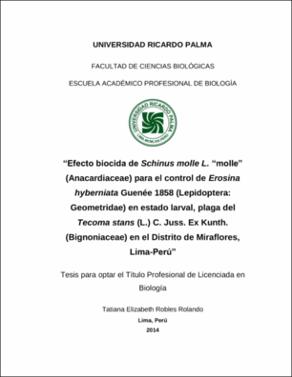| dc.description.abstract | Hoy en día, las municipalidades enfrentan grandes retos en implementar proyectos de manejo de plagas en sus áreas verdes, ya que estas áreas son parte fundamental de una zona urbana. La falta de conocimiento de usos de extractos botánicos como biocidas y además la bioecología de Erosina hyberniata (Lepidoptera: Geometridae) “Gusano del Tecoma”, limita el manejo de esta plaga que afecta al Tecoma stans “Huaranhuay”, especie ornamental en las áreas verdes urbanas en el distrito de Miraflores, Lima, Perú. Por esta razón el objetivo de esta investigación fue determinar el efecto biocida de Schinus molle L. (Anacardiaceae) para el control de E. hyberniata (Lepidoptera: Geometridae) en estado larval y además determinar el ciclo biológico de E. hyberniata bajo condiciones ambientales en el Laboratorio de Control Biológico de la Municipalidad de Miraflores. Las condiciones del laboratorio fueron 25,5ºC ± 1,6ºC y HR 65% ± 1%. Las muestras fueron recolectadas de los árboles del Distrito de Miraflores. La duración total en días del ciclo biológico fue de 34,47 ± 1,52 días. El promedio de desarrollo en días para cada fase fue: incubación de huevos 5,28 ± 0,64; desarrollo larval 22,86 ± 1,63, pre-pupa 2,95 ± 0,82 y pupa 12,05 ± 0,92. Se determinaron cinco instares larvales con duración de 3,94 ± 0,28; 4,26 ± 0,66; 4,57 ± 0,70; 4,16 ± 1,28 y 5,93 ± 1,46 días, respectivamente. El tiempo de vida de los adultos fluctuó entre un mínimo de 10 hasta un máximo de 13 días. La longevidad de hembras fue mayor al de los machos con 13 y 8 días, respectivamente. El periodo de pre-oviposición fue de 3,16 0,55 días, el periodo de oviposición 5,48 0,71 días y el periodo de post-oviposición 3,72 0,61 días. La capacidad de oviposición fue de 290,8 67 huevos con una viabilidad de 96%. El porcentaje de emergencia de adultos de E. hyberniata fue de 95%. El bioensayo con el extracto acuoso de S. molle entre 1,25 a 20% sobre larvas se observó que a 24 h y 48 h de exposición no mostró
efectividad, el extracto hexánico al 1,25% no mostró efectividad sin embargo el extracto hexánico al 2,5%, 5% y 10% a 24 h de exposición mostraron efectos en la mortalidad larvaria con 20%, 50% y 90% respectivamente y la CL50 fue 4,69% y a 48 h de exposición mostraron efectos con 22,5%, 55% y 100% respectivamente y la CL50 fue 40,08%.
Today, municipalities face major challenges in implementing projects pest management of green areas, as these areas are an essential part of an urban area. Lack of knowledge of use of botanical extracts as biocides and bio-ecology also Erosina hyberniata (Lepidoptera: Geometridae) "Tecoma worm", restricts the management of this pest of Tecoma stans "huaranhuay" ornamental species in landscaping urban in the district of Miraflores, Lima, Peru. Therefore the objective of this research was to determine the biocidal effect of Schinus molle L. (Anacardiaceae) to control E. hyberniata (Lepidoptera: Geometridae) in the larval stage and also determine the life cycle of E. hyberniata under ambient conditions in the Biological Control Laboratory of the Municipality of Miraflores. Laboratory conditions were 25,5 ° C ± 1,6 ° C and RH 65% ± 1%. Samples were collected from the trees in the Miraflores district. The total duration in days of the life cycle was 34,47 ± 1,52 days. The average development in days for each stage was: egg incubation 5,28 ± 0,64; 22,86 ± 1,63 larval development, pre-pupa and pupa 2,95 ± 0,82 12,05 ± 0,92. Five larval instars were determined with 3,94 ± 0,28; 4,26 ± 0,66; 4,57 ± 0,70; 4,16 ± 1,28 and 5,93 ± 1,46 days, respectively. The lifetime of adults ranged from a low of 10 to a maximum of 13 days. The longevity of females was higher than males with 13 and 8 days, respectively. The pre-oviposition period was 3,16 ± 0,55 days, the oviposition period was 5,48 ± 0,71 days and the period of post-oviposition was 3,72 ± 0,61 days. Oviposition capacity was 290,8 ± 67 eggs with a viability of 96%. The percentage of adult emergence of E. hyberniata was 95%. The bioassay with the aqueous extract of S. molle between 1,25 to 20% of larvae were observed at 24 h and 48 h of exposure showed no effectiveness, the 1,25% hexane extract showed no effectiveness but the hexane extract to 2,5%, 5% and 10% at 24 h of exposure showed effects on larval mortality with 20%, 50% and
90% respectively and the LC50 was 4,69% and 48 h of exposure showed effects with 22,5% 55% and 100% respectively and the LC50 was 4,08%. | es_ES |


